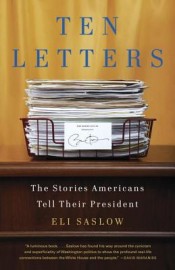One of my favorite ways to find new-to-me nonfiction writers (particularly writers who do journalistic nonfiction) is to read the long stories or profiles that get featured in major newspapers and magazines.
I fell in love with journalist Katy Butler’s writing because of a 2010 New York Times Magazine piece called “What Broke My Father’s Heart,” a look at medical interventions and our path to death. She has a book out next month that expands on the piece, Knocking on Heaven’s Door, that I’ve been reading rather slowly over the last few weeks. It’s equally as wonderful, and a book that probably wouldn’t have gotten on my radar without first reading her NYT piece.
That’s a roundabout way of getting to the reason why I read Ten Letters: The Stories Americans Tell Their President by Eli Saslow. In June, Saslow wrote a beautiful and, truly, heartbreaking profile of Mark and Jackie Barden, parents who lost their seven-year-old son Daniel in the shootings at Sandy Hook Elementary School. It’s a remarkably detailed and devastating piece that I couldn’t get out of my head hours after I read it.
Because I loved Saslow’s writing so much, I went online to see if he had written any books. I was glad to find Ten Letters, a 2011 book that explores the relationship between citizens and their president through the written word.
Every night, an aid delivers a briefing book to President Barack Obama. Included among the policy memos and scheduling details is a purple folder that contains 10 letters to the president. Every day, specific staff members at the White House sift through the thousands of letters and e-mails that arrive to choose these letters — 10 voices that presidential aides say help inspire the president and guide him towards that is happening across the country.
In Ten Letters, Saslow profiles 10 of the people who wrote to the president in late 2009 and early 2010. The subjects range in age, ethnicity, location, political affiliation and economic status. Yet all of them felt compelled, for one reason or another, to write directly to the president to have their voice heard. Most didn’t expect to hear back from him, but some did, and their reactions are part of this story too.
I started the book the day that it arrived in the mail and absolutely flew through it. It features exactly the same kinds of things that I loved from Saslow’s profile of the Barden’s, yet brings the stories together in a way that provides context about issues that still matter — health care, the economy, immigration, education. Saslow is able to use these individual stories to give context to Obama’s presidency and offer a snapshot of what it meant to be American at this specific moment.
Honestly, I’m getting the shivers just thinking back to how much I loved this book. Beyond admiring what great journalism it is, I felt inspired by these stories in a way that I don’t often expect from political writing. Saslow is a generous and talented writer who I hope will be writing more. Ten Letters is an amazing book and I hope that you will get a copy to read soon.


Comments on this entry are closed.
And were all these letters, PHYSICAL letters or were some via email? Just curious… Because you know I love snail mail.
Your enthusiastic endorsement has me really wanting to read the book, too.
They were a mix of both e-mail and physical letters — I can’t remember how many of each, but I do remember that the White House got a lot of both kinds to sort through.
Oh man do I want to read this! I just put it on my wish list. Thanks a million for reviewing this book. I know it will be something I’ll adore!
You will definitely like this one 🙂
Woah, this sounds like an amazing book. Such a cool concept and seems like great writing. Thanks for the review!
I have always firmly believed that each of us has a voice and that by using it, we can be heard and make a difference. This book is a testament to my belief. Thanks for bringing it to my attention. Will be looking for a copy.
Yes, that’s absolutely a theme in this book (and something that I believe as well).
I loved this book. I cried at the end.
That sounds remarkable.
I really enjoyed this book. I read/reviewed it last year when my school made it the “required freshman reading.” I wasn’t a freshman, but Eli Saslow DID come on campus and signed copies, so of course I had to be there! It was such an eye-opener for me. None of the information in it was new but it was a stark reminder of the difficulties average Americans face.
That’s how I felt too. It’s one thing to know these issues happen, but quite another to see how they affect real people. And we don’t get that without someone taking the time to find and write the stories. I loved it.
Oh wow, this sounds FABULOUS. I’m definitely going to keep an eye out for this – and start using your non-fiction hunting technique!
This sounds like a great read! I also love your method of finding new non-fiction authors. Since I don’t generally read newspapers, I’m not sure It’s a method I’ll adopt, but I’m definitely looking for a way to keep up to date on new non-fiction that works for me 🙂
I do most newspaper reading online, so I tend to find these stories via links on Twitter and whatnot. It’s fun to come across new authors that way.
I find that I discover most of my nonfiction reads from reading your blog. You always are reviewing so many interesting nonfiction picks. This one especially sounds interesting to me. Thank you for all the awesome recommendations!